Soheil Kolouri
ESPFormer: Doubly-Stochastic Attention with Expected Sliced Transport Plans
Feb 11, 2025Abstract:While self-attention has been instrumental in the success of Transformers, it can lead to over-concentration on a few tokens during training, resulting in suboptimal information flow. Enforcing doubly-stochastic constraints in attention matrices has been shown to improve structure and balance in attention distributions. However, existing methods rely on iterative Sinkhorn normalization, which is computationally costly. In this paper, we introduce a novel, fully parallelizable doubly-stochastic attention mechanism based on sliced optimal transport, leveraging Expected Sliced Transport Plans (ESP). Unlike prior approaches, our method enforces double stochasticity without iterative Sinkhorn normalization, significantly enhancing efficiency. To ensure differentiability, we incorporate a temperature-based soft sorting technique, enabling seamless integration into deep learning models. Experiments across multiple benchmark datasets, including image classification, point cloud classification, sentiment analysis, and neural machine translation, demonstrate that our enhanced attention regularization consistently improves performance across diverse applications.
Diffusion-Augmented Coreset Expansion for Scalable Dataset Distillation
Dec 05, 2024



Abstract:With the rapid scaling of neural networks, data storage and communication demands have intensified. Dataset distillation has emerged as a promising solution, condensing information from extensive datasets into a compact set of synthetic samples by solving a bilevel optimization problem. However, current methods face challenges in computational efficiency, particularly with high-resolution data and complex architectures. Recently, knowledge-distillation-based dataset condensation approaches have made this process more computationally feasible. Yet, with the recent developments of generative foundation models, there is now an opportunity to achieve even greater compression, enhance the quality of distilled data, and introduce valuable diversity into the data representation. In this work, we propose a two-stage solution. First, we compress the dataset by selecting only the most informative patches to form a coreset. Next, we leverage a generative foundation model to dynamically expand this compressed set in real-time, enhancing the resolution of these patches and introducing controlled variability to the coreset. Our extensive experiments demonstrate the robustness and efficiency of our approach across a range of dataset distillation benchmarks. We demonstrate a significant improvement of over 10% compared to the state-of-the-art on several large-scale dataset distillation benchmarks. The code will be released soon.
Understanding Learning with Sliced-Wasserstein Requires Rethinking Informative Slices
Nov 16, 2024Abstract:The practical applications of Wasserstein distances (WDs) are constrained by their sample and computational complexities. Sliced-Wasserstein distances (SWDs) provide a workaround by projecting distributions onto one-dimensional subspaces, leveraging the more efficient, closed-form WDs for one-dimensional distributions. However, in high dimensions, most random projections become uninformative due to the concentration of measure phenomenon. Although several SWD variants have been proposed to focus on \textit{informative} slices, they often introduce additional complexity, numerical instability, and compromise desirable theoretical (metric) properties of SWD. Amidst the growing literature that focuses on directly modifying the slicing distribution, which often face challenges, we revisit the classical Sliced-Wasserstein and propose instead to rescale the 1D Wasserstein to make all slices equally informative. Importantly, we show that with an appropriate data assumption and notion of \textit{slice informativeness}, rescaling for all individual slices simplifies to \textbf{a single global scaling factor} on the SWD. This, in turn, translates to the standard learning rate search for gradient-based learning in common machine learning workflows. We perform extensive experiments across various machine learning tasks showing that the classical SWD, when properly configured, can often match or surpass the performance of more complex variants. We then answer the following question: "Is Sliced-Wasserstein all you need for common learning tasks?"
Linear Spherical Sliced Optimal Transport: A Fast Metric for Comparing Spherical Data
Nov 09, 2024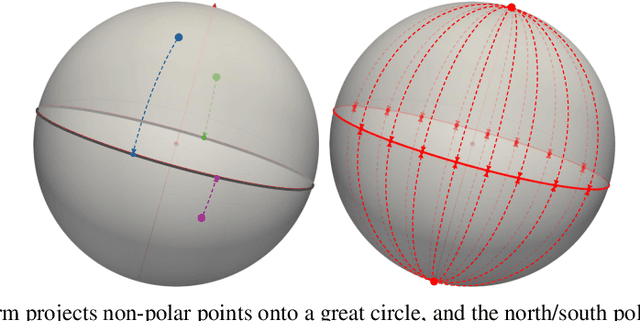
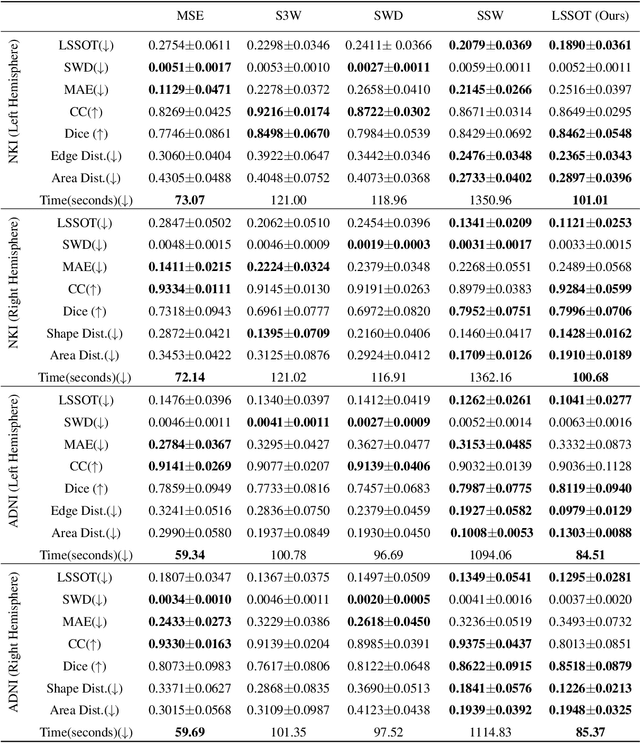

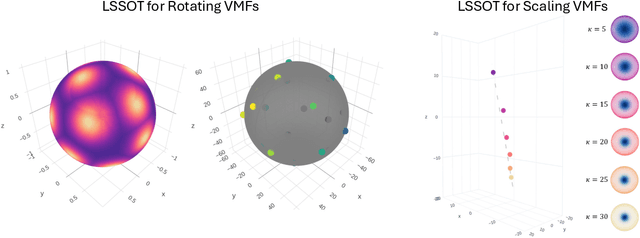
Abstract:Efficient comparison of spherical probability distributions becomes important in fields such as computer vision, geosciences, and medicine. Sliced optimal transport distances, such as spherical and stereographic spherical sliced Wasserstein distances, have recently been developed to address this need. These methods reduce the computational burden of optimal transport by slicing hyperspheres into one-dimensional projections, i.e., lines or circles. Concurrently, linear optimal transport has been proposed to embed distributions into \( L^2 \) spaces, where the \( L^2 \) distance approximates the optimal transport distance, thereby simplifying comparisons across multiple distributions. In this work, we introduce the Linear Spherical Sliced Optimal Transport (LSSOT) framework, which utilizes slicing to embed spherical distributions into \( L^2 \) spaces while preserving their intrinsic geometry, offering a computationally efficient metric for spherical probability measures. We establish the metricity of LSSOT and demonstrate its superior computational efficiency in applications such as cortical surface registration, 3D point cloud interpolation via gradient flow, and shape embedding. Our results demonstrate the significant computational benefits and high accuracy of LSSOT in these applications.
Linear Partial Gromov-Wasserstein Embedding
Oct 22, 2024



Abstract:The Gromov Wasserstein (GW) problem, a variant of the classical optimal transport (OT) problem, has attracted growing interest in the machine learning and data science communities due to its ability to quantify similarity between measures in different metric spaces. However, like the classical OT problem, GW imposes an equal mass constraint between measures, which restricts its application in many machine learning tasks. To address this limitation, the partial Gromov-Wasserstein (PGW) problem has been introduced, which relaxes the equal mass constraint, enabling the comparison of general positive Radon measures. Despite this, both GW and PGW face significant computational challenges due to their non-convex nature. To overcome these challenges, we propose the linear partial Gromov-Wasserstein (LPGW) embedding, a linearized embedding technique for the PGW problem. For $K$ different metric measure spaces, the pairwise computation of the PGW distance requires solving the PGW problem $\mathcal{O}(K^2)$ times. In contrast, the proposed linearization technique reduces this to $\mathcal{O}(K)$ times. Similar to the linearization technique for the classical OT problem, we prove that LPGW defines a valid metric for metric measure spaces. Finally, we demonstrate the effectiveness of LPGW in practical applications such as shape retrieval and learning with transport-based embeddings, showing that LPGW preserves the advantages of PGW in partial matching while significantly enhancing computational efficiency.
Expected Sliced Transport Plans
Oct 17, 2024
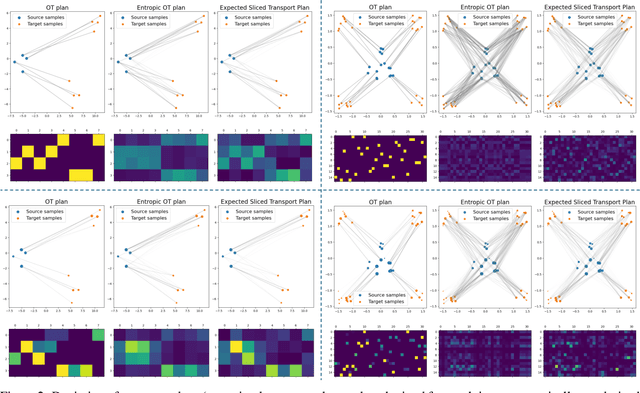
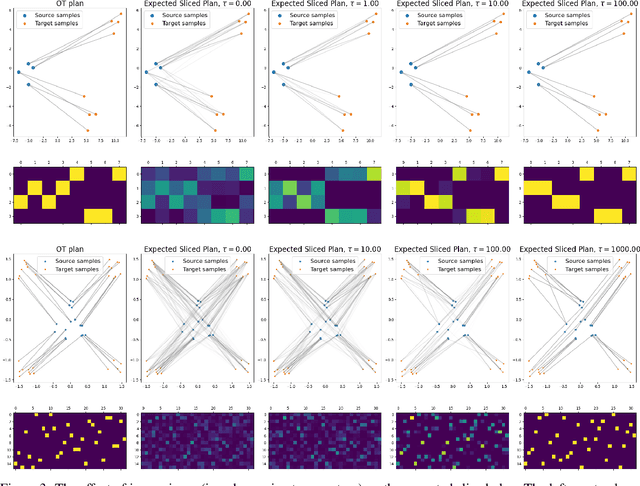
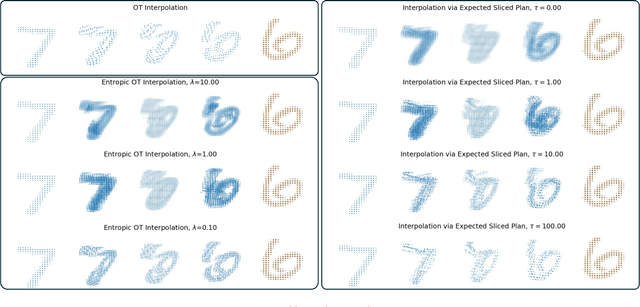
Abstract:The optimal transport (OT) problem has gained significant traction in modern machine learning for its ability to: (1) provide versatile metrics, such as Wasserstein distances and their variants, and (2) determine optimal couplings between probability measures. To reduce the computational complexity of OT solvers, methods like entropic regularization and sliced optimal transport have been proposed. The sliced OT framework improves efficiency by comparing one-dimensional projections (slices) of high-dimensional distributions. However, despite their computational efficiency, sliced-Wasserstein approaches lack a transportation plan between the input measures, limiting their use in scenarios requiring explicit coupling. In this paper, we address two key questions: Can a transportation plan be constructed between two probability measures using the sliced transport framework? If so, can this plan be used to define a metric between the measures? We propose a "lifting" operation to extend one-dimensional optimal transport plans back to the original space of the measures. By computing the expectation of these lifted plans, we derive a new transportation plan, termed expected sliced transport (EST) plans. We prove that using the EST plan to weight the sum of the individual Euclidean costs for moving from one point to another results in a valid metric between the input discrete probability measures. We demonstrate the connection between our approach and the recently proposed min-SWGG, along with illustrative numerical examples that support our theoretical findings.
NeuroBOLT: Resting-state EEG-to-fMRI Synthesis with Multi-dimensional Feature Mapping
Oct 07, 2024



Abstract:Functional magnetic resonance imaging (fMRI) is an indispensable tool in modern neuroscience, providing a non-invasive window into whole-brain dynamics at millimeter-scale spatial resolution. However, fMRI is constrained by issues such as high operation costs and immobility. With the rapid advancements in cross-modality synthesis and brain decoding, the use of deep neural networks has emerged as a promising solution for inferring whole-brain, high-resolution fMRI features directly from electroencephalography (EEG), a more widely accessible and portable neuroimaging modality. Nonetheless, the complex projection from neural activity to fMRI hemodynamic responses and the spatial ambiguity of EEG pose substantial challenges both in modeling and interpretability. Relatively few studies to date have developed approaches for EEG-fMRI translation, and although they have made significant strides, the inference of fMRI signals in a given study has been limited to a small set of brain areas and to a single condition (i.e., either resting-state or a specific task). The capability to predict fMRI signals in other brain areas, as well as to generalize across conditions, remain critical gaps in the field. To tackle these challenges, we introduce a novel and generalizable framework: NeuroBOLT, i.e., Neuro-to-BOLD Transformer, which leverages multi-dimensional representation learning from temporal, spatial, and spectral domains to translate raw EEG data to the corresponding fMRI activity signals across the brain. Our experiments demonstrate that NeuroBOLT effectively reconstructs resting-state fMRI signals from primary sensory, high-level cognitive areas, and deep subcortical brain regions, achieving state-of-the-art accuracy and significantly advancing the integration of these two modalities.
MCNC: Manifold Constrained Network Compression
Jun 27, 2024



Abstract:The outstanding performance of large foundational models across diverse tasks-from computer vision to speech and natural language processing-has significantly increased their demand. However, storing and transmitting these models pose significant challenges due to their massive size (e.g., 350GB for GPT-3). Recent literature has focused on compressing the original weights or reducing the number of parameters required for fine-tuning these models. These compression methods typically involve constraining the parameter space, for example, through low-rank reparametrization (e.g., LoRA) or quantization (e.g., QLoRA) during model training. In this paper, we present MCNC as a novel model compression method that constrains the parameter space to low-dimensional pre-defined and frozen nonlinear manifolds, which effectively cover this space. Given the prevalence of good solutions in over-parameterized deep neural networks, we show that by constraining the parameter space to our proposed manifold, we can identify high-quality solutions while achieving unprecedented compression rates across a wide variety of tasks. Through extensive experiments in computer vision and natural language processing tasks, we demonstrate that our method, MCNC, significantly outperforms state-of-the-art baselines in terms of compression, accuracy, and/or model reconstruction time.
Statistical Context Detection for Deep Lifelong Reinforcement Learning
May 29, 2024Abstract:Context detection involves labeling segments of an online stream of data as belonging to different tasks. Task labels are used in lifelong learning algorithms to perform consolidation or other procedures that prevent catastrophic forgetting. Inferring task labels from online experiences remains a challenging problem. Most approaches assume finite and low-dimension observation spaces or a preliminary training phase during which task labels are learned. Moreover, changes in the transition or reward functions can be detected only in combination with a policy, and therefore are more difficult to detect than changes in the input distribution. This paper presents an approach to learning both policies and labels in an online deep reinforcement learning setting. The key idea is to use distance metrics, obtained via optimal transport methods, i.e., Wasserstein distance, on suitable latent action-reward spaces to measure distances between sets of data points from past and current streams. Such distances can then be used for statistical tests based on an adapted Kolmogorov-Smirnov calculation to assign labels to sequences of experiences. A rollback procedure is introduced to learn multiple policies by ensuring that only the appropriate data is used to train the corresponding policy. The combination of task detection and policy deployment allows for the optimization of lifelong reinforcement learning agents without an oracle that provides task labels. The approach is tested using two benchmarks and the results show promising performance when compared with related context detection algorithms. The results suggest that optimal transport statistical methods provide an explainable and justifiable procedure for online context detection and reward optimization in lifelong reinforcement learning.
Physics informed cell representations for variational formulation of multiscale problems
May 27, 2024Abstract:With the rapid advancement of graphical processing units, Physics-Informed Neural Networks (PINNs) are emerging as a promising tool for solving partial differential equations (PDEs). However, PINNs are not well suited for solving PDEs with multiscale features, particularly suffering from slow convergence and poor accuracy. To address this limitation of PINNs, this article proposes physics-informed cell representations for resolving multiscale Poisson problems using a model architecture consisting of multilevel multiresolution grids coupled with a multilayer perceptron (MLP). The grid parameters (i.e., the level-dependent feature vectors) and the MLP parameters (i.e., the weights and biases) are determined using gradient-descent based optimization. The variational (weak) form based loss function accelerates computation by allowing the linear interpolation of feature vectors within grid cells. This cell-based MLP model also facilitates the use of a decoupled training scheme for Dirichlet boundary conditions and a parameter-sharing scheme for periodic boundary conditions, delivering superior accuracy compared to conventional PINNs. Furthermore, the numerical examples highlight improved speed and accuracy in solving PDEs with nonlinear or high-frequency boundary conditions and provide insights into hyperparameter selection. In essence, by cell-based MLP model along with the parallel tiny-cuda-nn library, our implementation improves convergence speed and numerical accuracy.
 Add to Chrome
Add to Chrome Add to Firefox
Add to Firefox Add to Edge
Add to Edge